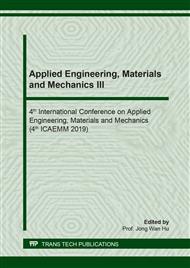[1]
WHO, Asenic - Sources of exposure; Available online: https://www.who.int/news-room/fact-sheets/ detail/arsenic, (2018).
Google Scholar
[2]
H. Brammera, P. Ravenscroft, Arsenic in groundwater: A threat to sustainable agriculture in South and South-east Asia, Environ. Int. 35(3) (2009) 647-654.
DOI: 10.1016/j.envint.2008.10.004
Google Scholar
[3]
R. L. Chaney et al. Phytoremediation of soil metals, Current Opinions Biotechnol. 8(3) (1997) 279-284.
Google Scholar
[4]
R. Tisarum, Y. Chen, X. Dong, J. T. Lessl, L. Q. Ma, Uptake of antimonite and antimonate by arsenic hyperaccumulator Pteris vittata: Effects of chemical analogs and transporter inhibitor, Environ. Pollut. 206 (2015) 49-55.
DOI: 10.1016/j.envpol.2015.06.029
Google Scholar
[5]
J. T. Lessl, J. Luo, L. Q. Ma, Pteris vittata continuously removed arsenic from non-labile fraction in three contaminated-soils during 3.5 years of phytoextraction, J. Hazard. Mater. 279(2014)485-492.
DOI: 10.1016/j.jhazmat.2014.06.056
Google Scholar
[6]
V. R. Angelova, R. V. Ivanova, K. I. Ivanov, M. N. Perifanova-Nemska, G. I. Uzunova, Potential of sunflower (Helianthus annuus L.) for phytoremediation of soils contaminated with heavy metals, World J. Sci. Eng. Technol. 10(9) (2016) 1-8.
Google Scholar
[7]
Nguyen Tien Cu, Tran Van Tua, Dang Dinh Kim, Do Tuan Anh, Le Thu Thuy, Study on the ability to process lead (Pb) in contaminated soil with Vetiver grass (Vetiveria zizanioides), Sci. Technol. J. 46(6A) (2008) 21-26.
Google Scholar
[8]
Bui Van Nang et al. Study on using syngonium podophyllum Schott to remove arsenic pollution in soil, J. Forestry Sci. Technol. 2 (2013) 82-87.
Google Scholar
[9]
T. K. A. Bui, Study on the use of plants (ferns) to treat arsenic contamination in soil in mineral mining areas. PhD thesis in University of Natural Sciences-Vietnam National University, (2011).
Google Scholar
[10]
V. K. Le, Methods of soil analysis of crop fertilizer, (2001).
Google Scholar
[11]
ASTM International, Standard Test Methods for Arsenic in Water, West Conshohocken, PA, ASTM D2972-03, (2013).
Google Scholar
[12]
ASTM International, Standard Test Methods for Practice for Use of the Terms Precision and Bias, West Conshohocken, PA, ASTM E177-08, (2008).
Google Scholar
[13]
D. D. Kim, Research on the use of plants to improve heavy metal contaminated soil in areas of mineral exploitation, J. Environ. (2011).
Google Scholar
[14]
Dong Thi Minh Hau et al. Research and selection of some plants capable of absorbing heavy metals (Cr, Cu, Zn) in mud dredging of Tan Hoa - Lo Gom canal, (2008).
Google Scholar
[15]
FAO, Compendium of Agricultural-Environmental Indicators 1989-2000. Rome: Food and Agriculture Organization of the United Nations Statistics Analysis Service, Statistics Division; Available online: http://www.fao.org/3/j0945e/j0945e00.htm, (2003).
Google Scholar
[16]
L.P. Tan, T.T. Lim, H. Jie, Mas screening of tropical plants to study their potential as heavy metal phytoremediators. Proceedings of the 10th International Conference on Environmental Science and Technology, (2008) 444-451.
Google Scholar
[17]
Wikimedia Foundation, Phytoremediation. Wikipedia-the free encyclopedia; Available online: https://en.wikipedia.org/wiki/Phytoremediation, (2019).
Google Scholar


